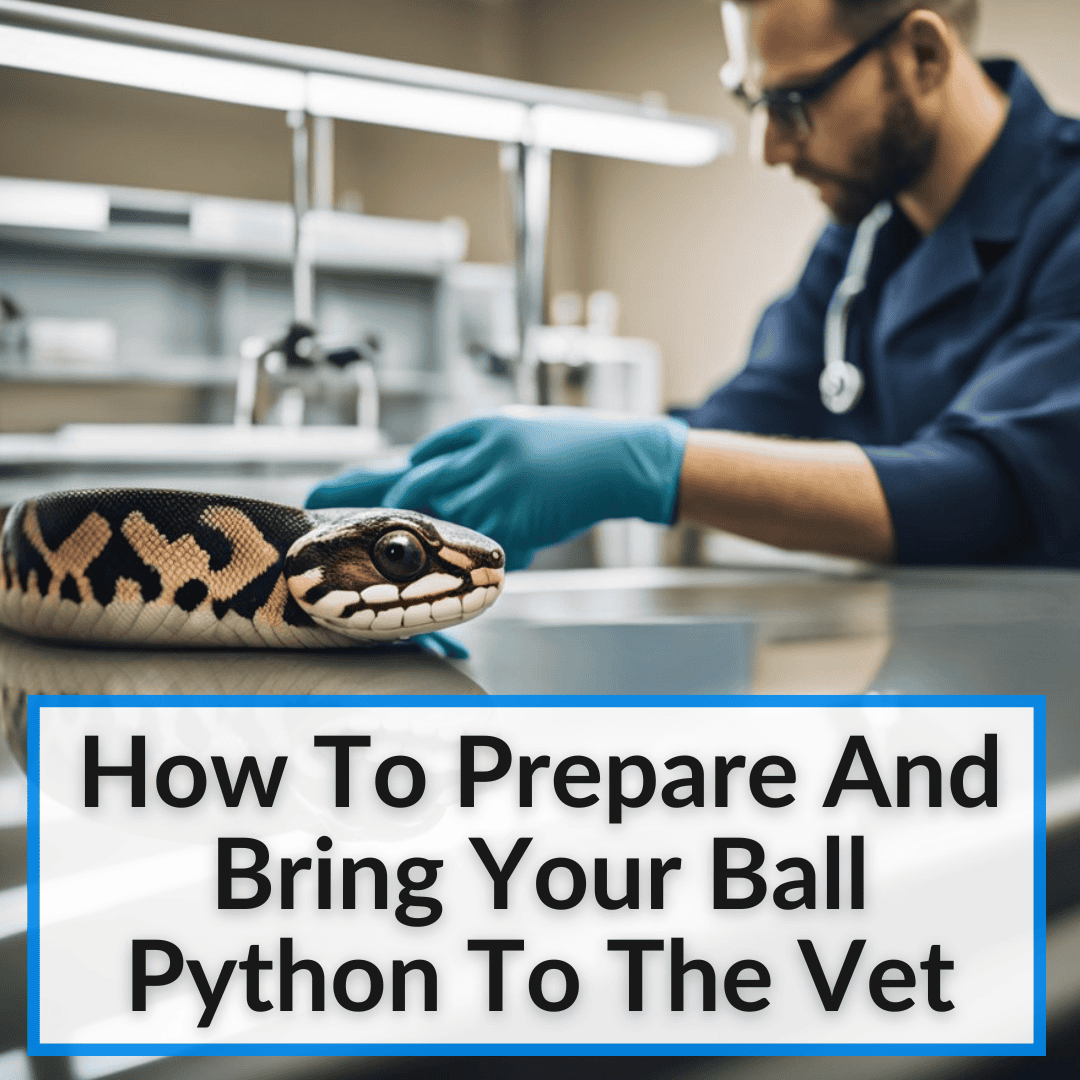
They are stressful for us, and even more stressful for our ball pythons.
But sometimes, there is nothing you can do.
When you have no choice but to bring your pet to the vet, it pays to know exactly how to prepare your ball python for a vet visit.
And how to go about actually taking it to the veterinary clinic.
Luckily, it is not difficult. The key is to minimize the stress on your snake.
Follow the step-by-step guide below to ensure you do just that.
Table of Contents
- 1 How To Prepare And Bring Your Ball Python To The Vet
- 1.1 Materials Needed
- 1.2 Step 1: Call The Vet Ahead Of Your Visit
- 1.3 Step 2: Preparing For The Travel
- 1.4 Step 3: Travel To The Vet
- 1.5 Step 4: At The Vet
- 1.6 Step 5: During The Examination
- 1.7 Step 6: Traveling Back With Your Pet
- 1.8 Step 7: Once Home
- 1.9 Step 8: Update Records And Document Everything
- 1.10 Step 9: Follow Up Visit
- 2 Taking A Ball Python to The Vet: Final Thoughts
How To Prepare And Bring Your Ball Python To The Vet
First, we will go over the materials you will need. Then we will get into the actual step-by-step guide.
Materials Needed
- Secure, escape-proof, and well-ventilated snake carrier or plastic container with a lid and holes. This is a good one that comes in different sizes.
- Pillowcase. This should have a light thread count so it is breathable for your snake. You could also just get a specialized snake bag that has a drawstring, like this one.
- Towels or cloth
- Hand sanitizer
- Temperature gauge (optional)
- Heat mat/heat pack/warming bottles/microwavable bean bags.
- Your ball python’s health records/breeder records, medical records of previous vet visits, and feeding schedules.
- A list of questions for the vet.
- Payment options – card, cash, etc.
Step 1: Call The Vet Ahead Of Your Visit

Find a vet specializing in reptile care or exotic animals, if you haven’t already. Visit the ARAV website to do so. Call the vet’s office ahead of your visit and inform them about your ball python’s symptoms and other concerns.
Calling ahead will help the veterinary staff members stay prepared so they can create an organized plan of action with clearly defined roles. They can also gather the necessary equipment your ball python needs.
This step can greatly minimize stress for your ball python and reduce the waiting time. Schedule the visit at a time convenient for you – one that will reduce travel time. Keep the visit as short as possible.
Step 2: Preparing For The Travel
Make sure your snake is well-fed and hydrated before the visit. This is important to minimize stress. Allow a few hours for it to digest its meal before traveling.
Sanitize your hands before picking up your ball python from its terrarium/enclosure. Approach your ball python calmly and quietly. Gently lift it out of its cage and place it in the breathable pillowcase. Place the pillowcase in a snake carrier or plastic container.
Make sure the container is clean and free of strong odors. You can line it with a towel or cloth for your snake’s comfort. Place another cloth or towel over the snake.
The plastic container should have a secure, lockable lid. It should also have holes for ventilation.
Place a portable heat source (a microwavable heat pack/bean bag/ warm bottle, etc.) inside the container to maintain a comfortable temperature for your ball python during the car ride.
If needed, use a temperature gauge to ensure that the temperature in the container is between 75 and 85° F.
Double-check the container to ensure its lid is secure. Allow your snake some time to adjust to the carrier.
Step 3: Travel To The Vet

If possible, take a travel companion along to hold the container in the car. This will minimize your ball python’s movement. If that is not possible, try to secure the container in the vehicle to prevent it from moving during the trip.
Ensure that the temperature inside the car is comfortable for your snake. You might want to warm or cool your vehicle beforehand, based on the ambient temperature. Avoid placing the container in direct sunlight or near the blast of the car’s AC vent.
Drive smoothly and avoid braking hard and taking sharp turns. Ensure there are no loud noises inside the car. This is necessary to minimize your ball python’s stress.
Step 4: At The Vet
Once you arrive at the vet, place your snake’s travel container in a secure area (either on the countertop or in your hand). You must adhere to any specific protocols or instructions provided by the veterinary clinic for reptile visits.
Inform the receptionist and provide them with your snake’s health care records and details of past visits as needed. Some vets require you to pay upfront. Provide your payment/pet insurance details as asked.
Wait for your turn. Make sure your snake is secure and comfortable in its container.
Step 5: During The Examination

Inform your vet about your ball python’s symptoms or any concerns you may have. Clearly describe the symptoms. If needed, refer to past visits.
Allow the vet to examine your snake. Be prepared to answer questions regarding the ball python’s behavior, last bowel movement, temperature in the enclosure, feeding schedule, diet, and other habits.
Your vet will recommend treatment, medication, and husbandry-related advice based on the snake’s symptoms and your input. Don’t hesitate to ask the vet any questions or express any concerns you may have about your ball python’s care. Ask about the next follow-up visit.
Step 6: Traveling Back With Your Pet
Once the exam is over, gently place your ball python back inside its pillowcase. Place the pillowcase in the carrier/container.
Some vet clinics also have a pharmacy onsite. You can purchase your pet’s medicine here. Alternatively, you may have to stop at another pharmacy or a pet shop to fill in the prescription medicines.
At the reception, make the payment (if you haven’t already) and schedule a follow-up appointment as advised.
Ensure a smooth journey back home. Follow the same precautions you did when you traveled to the vet: avoid bumps, jerks, and sharp turns, and maintain a comfortable temperature for your snake.
Step 7: Once Home
Once you get back, gently place your ball python back in its enclosure. Monitor your pet from time to time and watch out for behavioral changes. Follow your vet’s instructions regarding diet, habitat, and medicines.
If you notice any changes in your snake’s behavior or you think its condition has worsened, call the vet. You may have to bring it back to the vet if the symptoms worsen or if you do not see any signs of improvement.
Let your snake rest. Remember: a vet visit is likely to be very stressful for your ball python, so keep handling to a minimum.
Step 8: Update Records And Document Everything
Keep meticulous records and take photos of your ball python as needed. You might also want to note down everything the vet said – diagnoses, treatments, and recommendations.
Keep these records in a safe place and update them as you go. Review and organize everything for future vet visits.
Step 9: Follow Up Visit
As you continue monitoring your ball python’s health, make sure to take your snake for follow-up visits as directed. Follow the above steps to keep vet visits as stress-free as possible for your pet.
Taking A Ball Python to The Vet: Final Thoughts
Bringing your ball python to the vet requires careful preparation and attention to detail to ensure the experience is as stress-free as possible for your pet.
By gathering all necessary materials, calling the vet ahead of your visit, and following a structured travel plan, you can minimize your snake’s discomfort and anxiety.
During the vet visit, clear communication with the veterinarian about your ball python’s symptoms and history is crucial for effective diagnosis and treatment.
After the visit, ensure a smooth return home and closely monitor your snake’s recovery, adhering to the vet’s advice. Keeping detailed records and scheduling follow-up visits will help maintain your ball python’s health and well-being.
By following these steps, you can provide the best care for your ball python and ensure any health issues are promptly addressed.
Leave a Reply